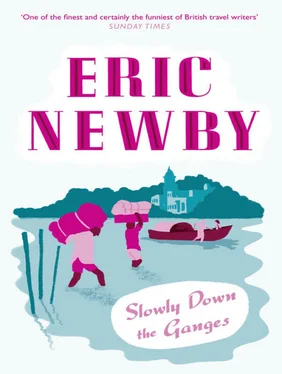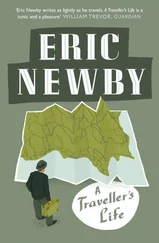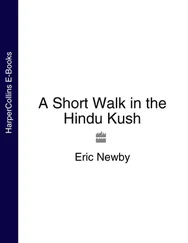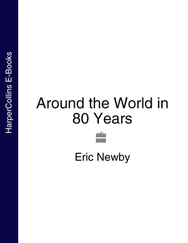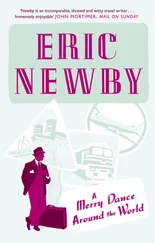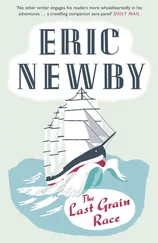
ERIC NEWBY
To Wanda – my fellow boatwoman
‘The Ganga has been a symbol of India’s age-long culture and civilisation, ever-changing, ever-flowing, and yet ever the same Ganga. She reminds me of the Himalayas, snow-covered peaks and the deep valleys which I have loved so much, and of the rich and vast plains below where my life and work have been cast.’
Jawaharlal Nehru
‘Here I asked repeatedly, and received a different account … Perhaps these particulars vary in different instances. At all events it is a proof how hard it is to gain, in this country, accurate information as to facts which seem most obvious to the senses.’
Narrative of a Journey through the Upper Provinces of India Reginald Heber, D.D., Lord Bishop of Calcutta
Cover
Title Page
Dedication
Epigraph
Maps
List of Illustrations
Introduction
1 Long ago on the Ganges
2 The first sight of the river
3 Life at Hardwar
4 Down the Ganges
5 Through the Bhabar
6 The way to the Balawali Bridge
7 A short halt at a railway station
8 An encounter with a bridgekeeper
9 Terra firma
10 A journey through Uttar Pradesh
11 A place in the country
12 From a carriage window
13 Remembrance of things past
14 Slow boat to Kanpur
15 Christmas at Kanpur
16 The Ganges at Prayag
17 The way to Mirzapur
18 The fort at Chunar
19 A stay at Banaras
20 The day of Makara Sankranti
21 From Patna to Bankipore and back
22 Cooking a Baffat
23 The islands at Colganj
24 Into the Bhagirathi
25 Arrival at Calcutta
26 Down to the sea
Plates
About the Author
Praise
Also by the Author
Copyright
About the Publisher
Footnotes
The course of the Ganges
From Hardwar to Bijnor
From Calcutta to Diamond Harbour
Stuck fast on the Upper Ganges, south of Hardwar
Newby carrying oars
Wedding at a village near the bridge at Raoli
Ram Baba, Lalta Prasad and Jagdish – our boatmen south of Fatehgarh, on the sands with a fire of stolen dung
Early morning
Between Allahabad and Mirzapur, with Bag Nath and Hira Lal
Bullock-cart from the ferry at Araul to Araul Mankapur
Devotee performing his morning puja
Mendicant child on the great sandbank at Allahabad
A bhur at Dinapore
Beggars on the way from Akbar’s embankment to the Sangam at the confluence of the Jumna and the Ganges at Allahabad
Dawn at the Sangam
A cremation at Banaras
Outside the post office at Banaras
A goddess
Wanda outside the Victoria Jubilee Club at Bankipore
The Ganges at Sultanganj – the embarkation point for the island of Jahngira
Arrival at Calcutta
This is the story of a twelve-hundred-mile journey down the Ganges from the place where it enters the Plains of India to the Sandheads, forty miles offshore in the Bay of Bengal, made by two Europeans in the winter of 1963–4. It is not an heroic story such as that of Franklin and his companions chewing leather on the banks of the Coppermine River but having got there (it is difficult to envy Franklin); of Ives seeing for the first time the great canyon of the Colorado; of Garnier reaching the headwaters of the Yangtze; or of Bailey and Morshead travelling sixteen hundred miles on foot through the gorges of the Tsangpo. We were born too late for such feats, even if we had had the courage and determination to perform them. We were even prevented from emulating the painter James Fraser’s long journey to the sources of the Bhagirathi Ganges – one which is made by numerous pilgrims – by the coming of the snow and our own meagre resources. It is not a book about India today; neither is it concerned with politics or economics. It is certainly not erudite, as must be obvious to anyone who has the patience to read it. It is about the river as we found it.
In most standard works of reference the Ganges does not even rate an entry in the tables which list the great rivers of the world, for it is only 1,500 miles long from its source in the Himalayas to the Bay of Bengal. The Nile, the Amazon, the Mississippi/Missouri are all more than two and a half times as long as the Ganges. The Irtysh and the Yangtze are both twice as long. The Congo, the Yellow River, the Mackenzie, the Niger, the Danube, the Euphrates, the Brahmaputra and the Indus, to name only a few, are all longer. But, all the same, it is a great river.
It is great because, to millions of Hindus, it is the most sacred, most venerated river on earth. For them it is Ganga Ma – Mother Ganges. To bathe in it is to wash away guilt. To drink the water, having bathed in it, and to carry it away in bottles for those who have not had the good fortune to make the pilgrimage to it is meritorious. To be cremated on its banks, having died there, and to have one’s ashes cast on its waters, is the wish of every Hindu. Even to ejaculate ‘ Ganga, Ganga ’, at the distance of 100 leagues from the river may atone for the sins committed during three previous lives.
In almost any bazaar in India one can buy a little, oblong paperback book. It is rather like a book of tickets for some Eastern tram service. It contains two works, bound up together. They are the Gangastottara-sata-namavali and the Ganga-sabasra-namastotra . They enumerate the 108 and the 1,000 names of the Ganges, all printed metrically and in columns so that they can be chanted devotionally; but unless one is an expert in Sanskrit, as was Colonel Pickering in Pygmalion , it is impossible to understand them. She is The Pure, The Eternal, The Light Amid the Darkness, The Cow Which Gives Much Milk, The Liberator, The Destroyer of Poverty and Sorrow, The Creator of Happiness, to give only a few of her names. 1
The Ganges was not always so highly regarded. When the Aryan invaders first entered India they were more impressed by the Indus. It was only later that they gave Ganga the highest position, as Sursari , River of the Gods – perhaps because they had found out what European scientists discovered later: that its water has remarkable properties. Bottled, it will keep for at least a year. At its confluence with the River Jumna which, particularly at the time of the great fair which takes place there every January, contains dangerous numbers of coli , the Ganges itself is said to be free of them. At Banaras thousands drink the water every day at bathing places which are close to the outfalls of appalling open drains. They appear to survive. The presence of large numbers of decomposing corpses seems to have no adverse effect on it. (Before setting off we were advised that when we wanted to make tea sedimentation could be accelerated by stirring it with a stick of alum; but we never did this.) Taken on board sailing ships in the Hooghly at Calcutta it is said to have outlasted all other waters. In spite of this many Hindus have reservations about how far downriver they are prepared to drink it. Some say as far as Dhulian, near the place where the Ganges under the name of the Bhagirathi and later the Hooghly, takes off for Calcutta. The inhabitants of Soron, on the Upper Ganges far north of cities like Allahabad and Banaras, believe that this is the last point at which the water is really good because, they say, no sewage has yet entered it. (At Soron there is a large tank, reputed to be fed by the Ganges, the waters of which have the peculiar property of dissolving the bones of the dead within three days of their being deposited in it.)
Читать дальше
